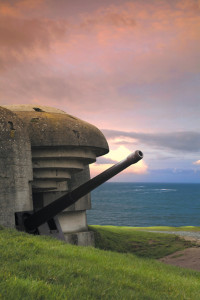May – the in-between month. Holidays are long gone and more time will lapse before summer vacation begins; weather struggling between still cold and too-early hot. So what’s to write about that might be current. Anything in my passport that might fit in here? I’ve got it – June 6, 1944, the day called D-Day. Let me share my trip down the Normandy coast. Talk about what has changed and what has not in the past 70-plus years. Maybe remind you of a few movies you have seen and of a few older vets who remember being there.
 We started our trip at the city of Arromanches-les-Bains. This seaport isn’t often mentioned because it was not one of the original landing sites. In fact, it sits between them. The British and Canadian landing sites named Juno, Gold, and Sword sit to the east, while those of the United States, Omaha and Utah, are to its west. But this little known spot was perhaps the most important of them all. Why? Well, an old army proverb says “An Army marches on its stomach.” Without food, medical supplies, and ammunition the entire project collapses. There on the beach, at an artificial temporary harbour, all of those goodies came ashore. This pier also served as the location for loading wounded or stranded warriors who were heading back to England. The plan was actually quite imaginative. In Britain they built huge floating concrete caissons which, after being towed from England, then had to be assembled to form walls and piers which defined an artificial spot named the Mulberry harbour. When they got there they were scuttled and sunk, forming a concrete pier going from dry land well out into the English Channel. Ships could tie up alongside the pier to unload and reload, and supplies and troops streamed in and out.
We started our trip at the city of Arromanches-les-Bains. This seaport isn’t often mentioned because it was not one of the original landing sites. In fact, it sits between them. The British and Canadian landing sites named Juno, Gold, and Sword sit to the east, while those of the United States, Omaha and Utah, are to its west. But this little known spot was perhaps the most important of them all. Why? Well, an old army proverb says “An Army marches on its stomach.” Without food, medical supplies, and ammunition the entire project collapses. There on the beach, at an artificial temporary harbour, all of those goodies came ashore. This pier also served as the location for loading wounded or stranded warriors who were heading back to England. The plan was actually quite imaginative. In Britain they built huge floating concrete caissons which, after being towed from England, then had to be assembled to form walls and piers which defined an artificial spot named the Mulberry harbour. When they got there they were scuttled and sunk, forming a concrete pier going from dry land well out into the English Channel. Ships could tie up alongside the pier to unload and reload, and supplies and troops streamed in and out.
These “concrete hunks” were very difficult to remove so many of them remain visible from the shore, sitting about where they were sunk some seventy years ago. A few of them, I’m told, went on to greater things. They were purchased by the Dutch and are now doing their thing as part of dikes to hold water back on the coast of the Netherlands.
Our next stop, just to the west, was to visit the remnants of the German gun positions. These elaborate bunkers housed huge 105 mm rifles, cannons if you prefer, that could hurl a shell twelve miles. An observer on the cliff’s edge would call out range and distance, and from the bunkers these huge weapons would launch shells at either the fleet of ships or the shore’s landing sites. In contrast these days an unmanned drone, remotely controlled, using GPS for the location of its target, could easily accomplish the same task with far more accuracy. The bunkers are now old and the remaining guns rusted, but they still give off a sense of foreboding.
Our third stop was the American Cemetery just above Omaha beach. I could write a separate story on the beauty and serenity of this place. Statistics and history abound, but I am not going there. Instead I will share with you one of my quests while visiting the site.
Over the years I’ve talked to many who were there on D-Day and who participated in the mighty endeavor. I’ve also watched a lot of films out of Hollywood which told stories, often sugar-coated, of what happened there. To a man, all participants said the movie “Saving Private Ryan” was by far the most realistic.
You may recall that three of Private Ryan’s brothers were victims in this war. Two had died on or just after D-Day, the third was a POW of the Japanese. This film was based on a true family story of the brothers whose real name was Nyland. One of my quests was to find their resting places. This took me into the vast cemetery with a goal and a purpose.
At the Information Center I looked up their location and found it to be A-19. Admittedly I wandered around looking out to sea over the beaches and did read the history of ten or twelve others buried there. In the end, I found the Lieutenant Nyland’s grave and his Staff Sergeant brother’s also – with white marble crosses standing on each.
This was enough for me. The oft-stated truism became reality here, namely the United States of America has conquered a great deal of land over its history. But we have always returned it to the inhabitants who were there before we came. The only ground we have asked for and kept has been the plots of our soldiers who died liberating the land.
Rest in peace.
Leave a Reply